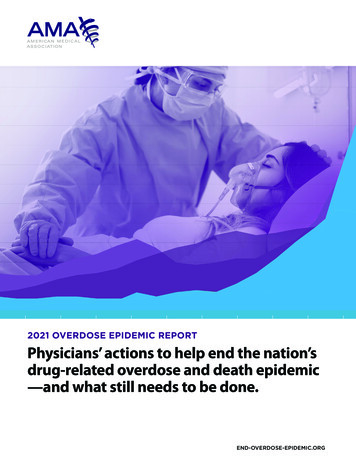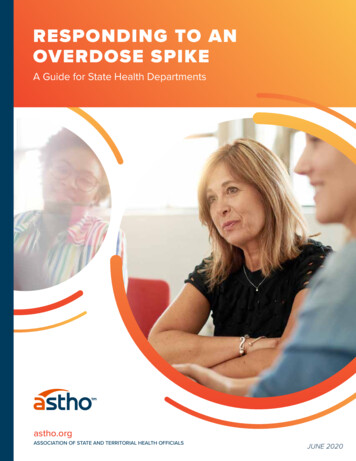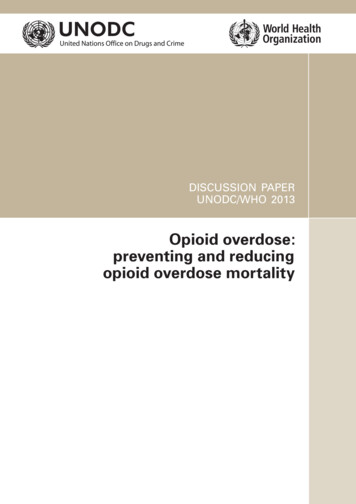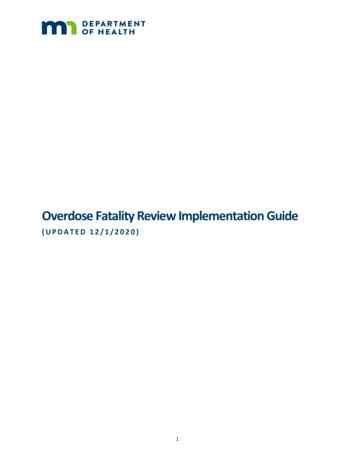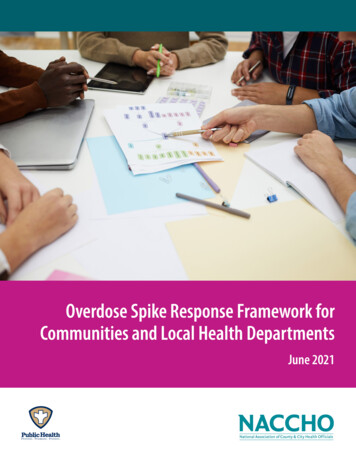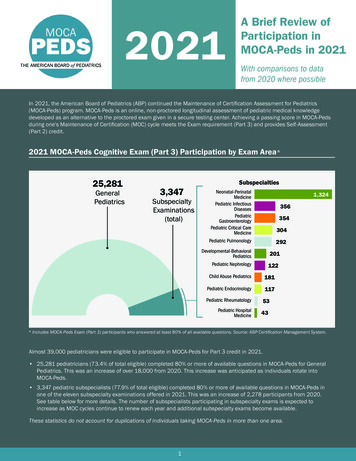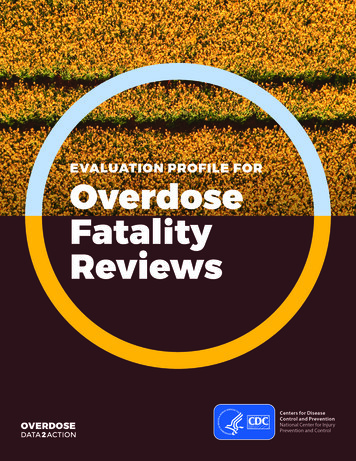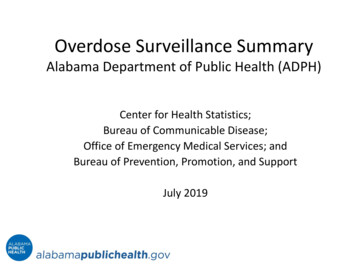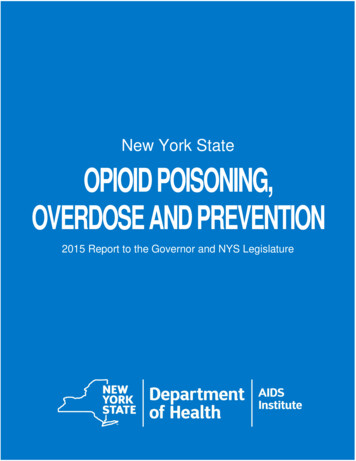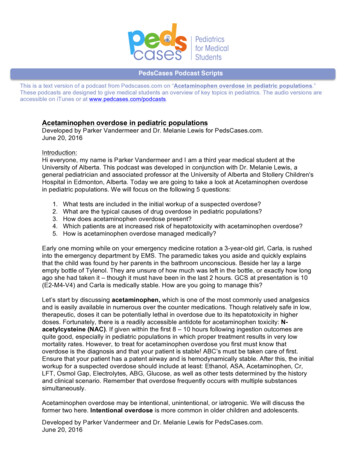
Transcription
PedsCases Podcast ScriptsThis is a text version of a podcast from Pedscases.com on “Acetaminophen overdose in pediatric populations.”These podcasts are designed to give medical students an overview of key topics in pediatrics. The audio versions areaccessible on iTunes or at www.pedcases.com/podcasts.Acetaminophen overdose in pediatric populationsDeveloped by Parker Vandermeer and Dr. Melanie Lewis for PedsCases.com.June 20, 2016Introduction:Hi everyone, my name is Parker Vandermeer and I am a third year medical student at theUniversity of Alberta. This podcast was developed in conjunction with Dr. Melanie Lewis, ageneral pediatrician and associated professor at the University of Alberta and Stollery Children'sHospital in Edmonton, Alberta. Today we are going to take a look at Acetaminophen overdosein pediatric populations. We will focus on the following 5 questions:1.2.3.4.5.What tests are included in the initial workup of a suspected overdose?What are the typical causes of drug overdose in pediatric populations?How does acetaminophen overdose present?Which patients are at increased risk of hepatotoxicity with acetaminophen overdose?How is acetaminophen overdose managed medically?Early one morning while on your emergency medicine rotation a 3-year-old girl, Carla, is rushedinto the emergency department by EMS. The paramedic takes you aside and quickly explainsthat the child was found by her parents in the bathroom unconscious. Beside her lay a largeempty bottle of Tylenol. They are unsure of how much was left in the bottle, or exactly how longago she had taken it – though it must have been in the last 2 hours. GCS at presentation is 10(E2-M4-V4) and Carla is medically stable. How are you going to manage this?Let’s start by discussing acetaminophen, which is one of the most commonly used analgesicsand is easily available in numerous over the counter medications. Though relatively safe in low,therapeutic, doses it can be potentially lethal in overdose due to its hepatotoxicity in higherdoses. Fortunately, there is a readily accessible antidote for acetaminophen toxicity: Nacetylcysteine (NAC). If given within the first 8 – 10 hours following ingestion outcomes arequite good, especially in pediatric populations in which proper treatment results in very lowmortality rates. However, to treat for acetaminophen overdose you first must know thatoverdose is the diagnosis and that your patient is stable! ABC’s must be taken care of first.Ensure that your patient has a patent airway and is hemodynamically stable. After this, the initialworkup for a suspected overdose should include at least: Ethanol, ASA, Acetaminophen, Cr,LFT, Osmol Gap, Electrolytes, ABG, Glucose, as well as other tests determined by the historyand clinical scenario. Remember that overdose frequently occurs with multiple substancessimultaneously.Acetaminophen overdose may be intentional, unintentional, or iatrogenic. We will discuss theformer two here. Intentional overdose is more common in older children and adolescents.Developed by Parker Vandermeer and Dr. Melanie Lewis for PedsCases.com.June 20, 2016
They usually involve a single, large dose of acetaminophen and may be disclosed onpresentation or detected with a toxicology screen. Intentional over dose rarely occurs in by theactions of younger children, though on occasion caregivers will intentionally give high doses ofacetaminophen in an attempt to poison infants and young children. Unintentional overdose ismore common with younger children. It may be the result of exploratory accidental ingestion ofacetaminophen by young children who like to put everything they find into their mouth, orinappropriate dosing by caregivers who were trying to treat symptoms and who were not tryingto harm the child. These unintentional overdoses may be caused by frequent dosing, doseswhich are to high, consumption of multiple acetaminophen containing products, “intentional”overdosing due to the perceived lack of improvement on pediatric doses, or by two caregiversunknowingly both treating the child among other things. Unfortunately, the signs and symptomsof overdose may mimic the symptoms which the caregivers were trying to treat – propagatingthe issue and delaying treatment. Caregivers may also be hesitant to admit their mistake whileunderestimating the potential toxicity of overdose. In general, younger children are lesssusceptible to developing hepatotoxicity. Though age may be used to dose acetaminophen inpediatrics, it is better to dose by weight. The maximum daily dose of acetaminophen for childrenunder 50kg or 12 years of age should not exceed 75mg/kg/day, and is generally prescribed as10 – 15mg/kg q4-6h PRN.τAfter a thorough history you discover that Carla and both of her parents have been sufferingfrom an uncomplicated cough with headaches and rhinorrhea for the past two days. Carla hadbeen given Tylenol in the past by her parents for headaches, and was heard earlier this morningcomplaining that “her head was hurting”. Carla’s father tells you that he is concerned she hadtaken a large amount of the Tylenol thinking that it would stop her headache.Carla is otherwise healthy, has NKDA, no PMHx, and takes no medications regularly – otherthan 800UI of Vitamin D daily.Acute acetaminophen overdose can be divided into four stages. In the first 24 hours it iscommon for pediatric patients to be asymptomatic. However, nausea and vomiting; diaphoresis;lethargy; and malaise may be present. This early on laboratory tests may be relatively normal.Remember that you want to treat within the first 8 – 10 hours, so these are the symptoms andsigns to watch for! 1 – 3 days following ingestion signs of hepatorenal toxicity start to appearand most of the initial symptoms have improved. In those who have sustained organ damagelaboratory results will be abnormal. RUQ pain and an enlarge liver may be found on physicalexam. 3 – 4 days following ingestion the initial symptoms may start to reappear. If the overdosedid damage, this is when your lab tests will peak. There are very few things that can elevateALT and AST above 10 000. Acetaminophen is one of them! Stigmata of liver dysfunction willappear at this stage, and in severe overdose renal failure may also occur. If the patient is goingto die from their overdose, it is generally during this 3 – 4 day post ingestion window. 4 days to 2weeks following ingestion shows clinical recovery, followed by some histologic recovery andnormalizing of laboratory values over the following weeks. If, after assessment, you have reasonto believe that the amount of acetaminophen ingested was not significant enough to causeserious toxicity no treatment is necessary.There are several conditions which increase an individuals’ susceptibility to developing hepatictoxicity. Patients who are elderly, have restricted diets, lack the building blocks necessary erviewτDeveloped by Parker Vandermeer and Dr. Melanie Lewis for PedsCases.com.June 20, 2016
glutathione synthesis, have underlying hepatic or renal disease, or have a compromisednutritional status a number of conditions including HIV, alcoholism, cystic fibrosis, or eatingdisorders are at increased risk and may not require as high of doses to reach toxic levels. Inaddition to these conditions, medications and drugs which are metabolized by CYP450 alsoincrease the risk of hepatocellular injury. Some common examples include: alcohol, tobacco,phenytoin, carbamazepine, TMP-SMX, and barbiturates.Carla appears ill and lethargic; she is quiet sweaty but has not vomited. You order liver andkidney function tests, ALT, AST, an acetaminophen level, electrolytes, blood glucose, and anABG in addition to starting an IV and giving a bolus of normal saline, followed by maintenancefluids. Although you know that it is unlikely that accidental overdose will cause serious toxicity,you order that NAC be started as well as activated charcoal, as it has been less than 4 hourssince ingestion.In those patients in which there is a risk of serious toxicity treatment needs to be started ASAP.Unintentional overdose, especially exploratory, is less likely to be in doses high enough tocause serious toxicity. However, it is still important to do your initial workup, including andacetaminophen level. An acetaminophen level should also be taken if either the dose, or thetime of ingestion, are unknown. For any overdose presenting within 4 hours of ingestionactivated charcoal should be considered to decrease the amount of acetaminophen available tobe absorbed into the blood. There is little evidence to support giving activated charcoal after 4hours unless medications which slow gastric motility were also ingested at the same time. Aserum acetaminophen level must be ordered 4 or more hours following ingestion. If extendedrelease acetaminophen was taken a second level should be taken 4 hours after the first. Thisvalue can then be plotted on the acetaminophen nomogram to aid in determining if treatment isnecessary. Keep in mind that this nomogram can only be used for single dose ingestions, and isuseless if ingestion took place more than 24 hours ago. Remember that treatment should not bedelayed waiting around for lab results. If you do not know how much was ingested, or know thatit was a potentially toxic amount, start treatment with activated charcoal (if within 4 hours ofingestion) and NAC before lab values return! INR, PTT, ALT, AST, and CR should be monitoredthroughout ildren-andadolescents?source search result&search Acetominophen Overdose&selectedTitle 2 50ξDeveloped by Parker Vandermeer and Dr. Melanie Lewis for PedsCases.com.June 20, 2016
Acetaminophen Nomogram:ψIn patients presenting more than 24 hours post ingestion with signs and symptoms of liverfailure are still potential candidates for NAC. These patients may have nausea, vomiting, signsof liver failure, hypotension, hepatic encephalopathy, cerebral edema, among other symptoms.They may require urgent resuscitation or care in an Intensive Care Unit, which will not bediscussed here.As a rule of thumb you should be concerned about acetaminophen toxicity in pediatric patientswhen the single dose exceeds 7.5g or 150mg/kg. If presenting within 4 hours activated charcoalshould be given at a dose of 1g/kg up to 50g PO. Contraindications to activate charcoal includealtered mental status with an unprotected airway and gastrointestinal obstruction. Around 30%of patients will develop nausea and vomiting with oral activated charcoal so consider giving anantiemetic, like Ondansetron or Metoclopramide, with it.NAC should be given within 8 – 10 hours following ingestion, but still shows benefit if given afterthis period. Consider NAC when the dose exceeds 7.5g or 150mg/kg; the time of ingestion isunknown and acetaminophen plasma concentrations are 10mg/L; serum dia/commons/9/9b/Rumack Matthew nomogram with treatment %28study%29 line.pdfDeveloped by Parker Vandermeer and Dr. Melanie Lewis for PedsCases.com.June 20, 2016
levels are above the treatment line on the nomogram; and in patients presenting more than 24hours after ingestion with either symptomatic or laboratory signs of hepatotoxicity. While NACcan be given PO -- at a loading dose of 140mg/kg followed by 70mg/kg q4h x 17 doses – this israrely done in pediatrics as NAC tastes horrible! More commonly in pediatrics NAC is given IV.The dosing and administration is complicated and beyond the scope of this podcast, but it isimportant to remember that it should be done in conjunction with a physician who hasexperience administering NAC IV. Potential complications of NAC include hyponatremia,seizures, and death. In children over 40kg NAC can be prescribed as per adults, in children lessthan 40kg a total dose of 300mg/kg should be given over 21 hours. As mentioned, this is not asimple infusion, and requires special monitoring to reduce the risk of adverse events.It is now around 9 hours post ingestion and Carla’s 8 hour acetaminophen level has just arrived.At 47µg/mL she falls below the line of treatment on the nomogram and you decided todiscontinue the NAC while continuing the maintenance fluids. You order ALT, AST, LFT, Cr,Acetaminophen level, and Electrolytes to be completed in 4 hours and then go to see Carla andher parents.Carla is looking significantly better than when she first presented. You let Carla and her parentsknow that the recent lab work shows that we are likely out of the danger zone for toxicity, butthat you would like to keep an eye on everything for a few more hours just to make sure. Youthen briefly discuss how important it is to “always ask mom and dad about taking medicine” withCarla as well as options for keeping medications safe from children with her parents. Carla issent home in the morning healthy and happy.In summary, acetaminophen is an easily accessible and commonly used analgesic. Inoverdose, it has the potential to prove lethal if not treated with NAC and supportive care quickly.With treatment, outcomes improve significantly and fatalities are rare. As such, it is important toalways keep in mind the possibility of acetaminophen overdose in patients presenting after aknown or suspected suicide attempt. In patients in which accidental ingestion is suspected,education on proper medication storage is vital. Today, we have briefly gone over the work up,etiologies, presentation, and management of acetaminophen overdose in a pediatric population.Hopefully you have found this podcast helpful and informative, thanks for listening!Developed by Parker Vandermeer and Dr. Melanie Lewis for PedsCases.com.June 20, 2016
Acetaminophen overdose may be intentional, unintentional, or iatrogenic. We will discuss the former two here. Intentional overdose is more common in older children and adolescents. PedsCases Podcast Scripts This is a text version of a podcast from Pedscases.com on "Acetaminophen overdose in pediatric populations."

